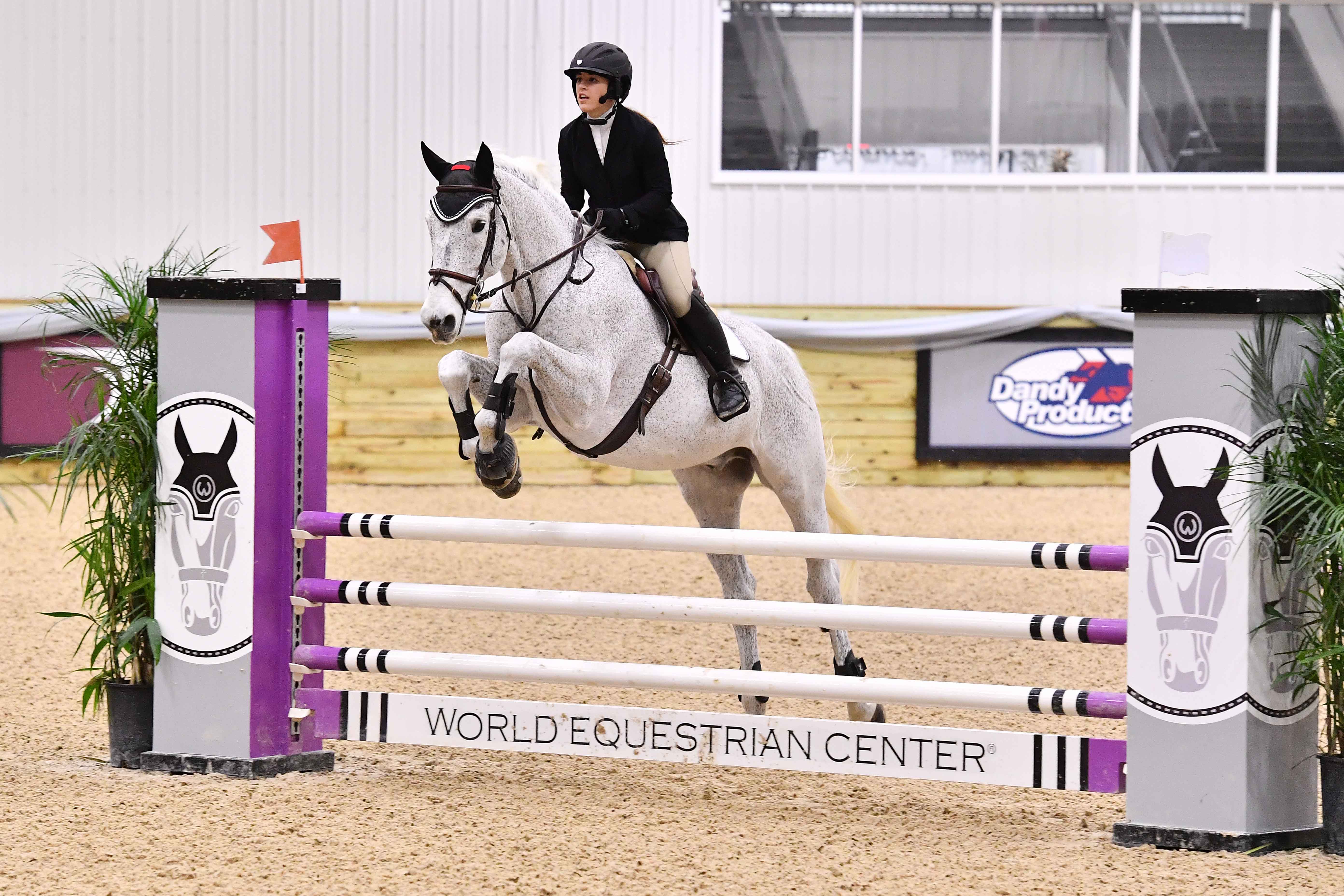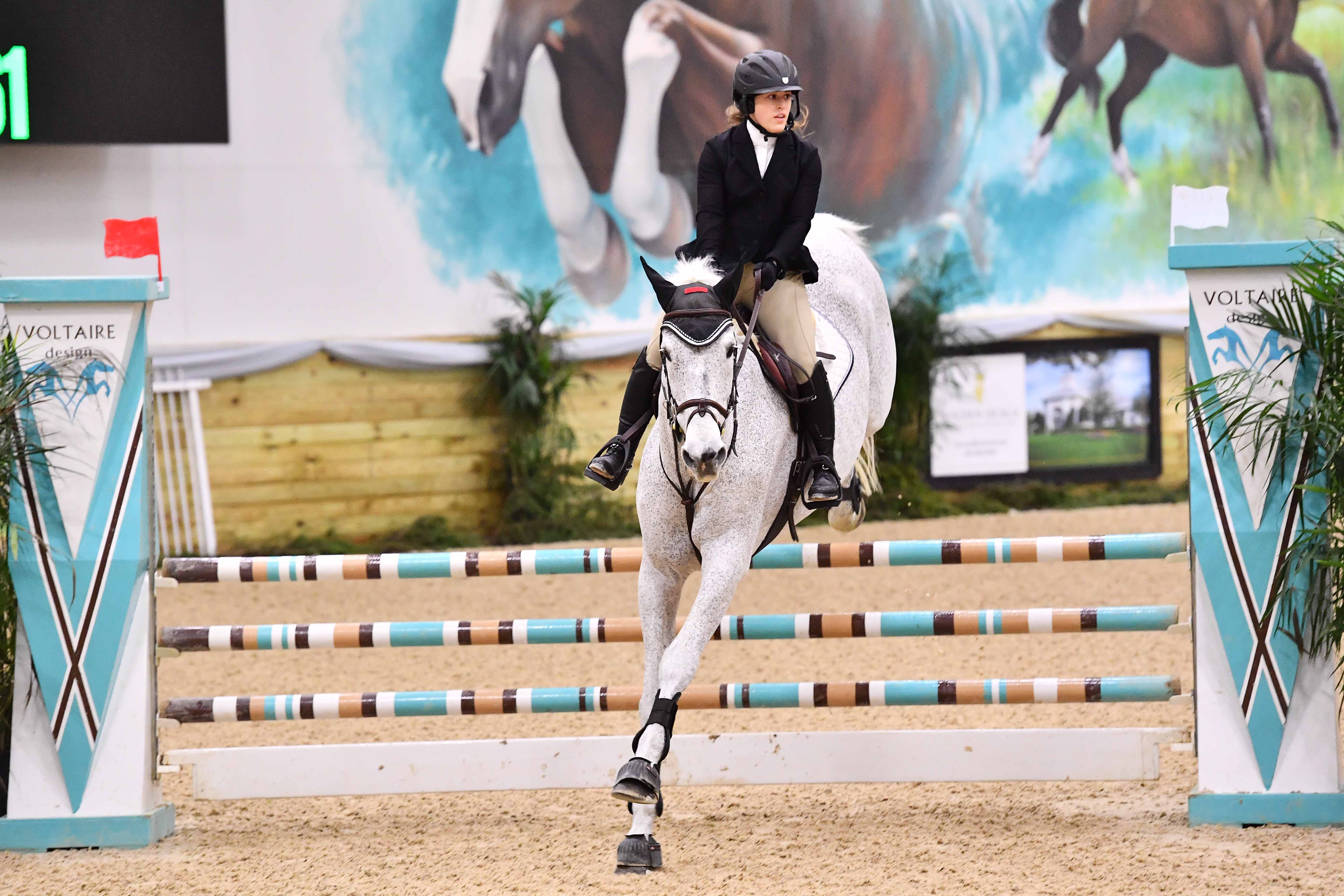
This week’s Sunday Spotlight lands on Wren Blae Zimmerman, a true inspiration whose dreams extend far beyond her own riding. Wren has a visual impairment that impedes her from seeing what is in front of her and was told that jumping wasn’t a feasible route for her to take. Despite the many times she has heard the word no, Wren has prevailed and is well on her way to live out her dream of becoming an elite-level show jumper. Case in point, Wren and her mount Cassicasca, or ‘Valentine’, showed to top placings in the Low Adult Jumpers at World Equestrian Center this week. We were delighted that Wren took the time to sit down and share her incredible story with us.
WEC: Tell us about yourself.
Wren: I have Stargardt’s macular dystrophy, which is a progressive degenerative retina disease. I got diagnosed with it when I was a senior in high school. About halfway through college I became legally blind, or blind even with the aid of corrective lenses. Essentially the path that I had set out on before I started losing my vision was to get an MBA and do management and marketing in the corporate world. That wasn’t really feasible anymore, so I ended up putting business school on hold and wanted to fulfill my life-long dream of riding and jumping horses. I do that full time now.
WEC: How did you get started riding?
Wren: I have always had an affinity for horses. I wanted to ride ever since I was little. Unfortunately, my parents didn’t support that, so it was only after I graduated from college that I was able to start. That was about five or six years ago now.
I actually started at a therapeutic riding center. I’m visually impaired, or legally blind. The therapeutic riding center let me exercise ride their horses, so I sort of learned how to ride that way. I always wanted to jump, but the instructor told me that wasn’t really feasible because I’m blind. I thought, “Well, I’m putting this much time into it, so I think I’m going to try to go elsewhere.”
I found a trainer who was willing to let me try to jump. She put me on one of her horses and let me try. I think it was about a week or two after I started riding with her that she took me to a schooling show and I did the Beginner Hunters and won the division. She brought me up to doing the 1.00m jumpers over the course of three to four years. My riding is kind of unconventional. I’m able to ride through grants, sponsorships and private donors.
WEC: Tell us about the impact that a visual impairment has on riding.

Wren: My central vision is pretty much blank about the size of a dinner plate. My peripheral vision is really blurry. Instead of there being a blank spot in the center, my brain uses what it sees in the peripheral to guess what should be in the center. It almost ends up sparkling, sort of.
It’s really interesting. One of the things that people ask is how do I learn my courses and how do I find the jumps. I do a lot of prep work. I walk the perimeter of the arena, then I walk the quarter line, so I get a really good sense of the area that I’m going to be riding in. I’ll go to walk the course with an aid, a lot of times that is my boyfriend Nick, and we’ll stand at each jump and he’ll tell me, “About five feet away is a blue jump at this angle, then you turn and about ten feet away is a yellow jump at this angle.” We do that pretty much at every jump, so I get this mental map of where everything is. I also have this giant whiteboard with little magnets for the jumps so that I can kind of find my way through that. Then, I write it out on a big piece of paper ahead of time and color code it.
Essentially, the more contrast there is in color and the larger the surface area, the easier it is for me to see a blur of color. In the jumper ring, I can come around a turn and I can make out a blur of yellow, so I know to head toward that. The way I get straight to my jumps is I have an earpiece accommodation from the USEF, so my trainer will count down, “Three, two, one,” to turn off of the rail to make sure I’m getting straight. My trainer also helps me to get the right distances and stuff, because obviously I can’t see the jumps. It’s a long process just to get myself into that arena and know where I’m going, but I have everything memorized by the time I get in there.
WEC: Tell us about your horse.

Wren: His name is Cassicasca, or ‘Valentine’ in the barn. I’m actually leasing him. We moved from Portland, Oregon about a year and a half or two years ago so that I could pursue riding more seriously. I was searching for a horse. A woman named Nicola Fry owns him and she bought him for her daughter who had stopped riding, so he was available for lease. I tried him and it was one of those times where you get on and you just know it’s the right fit.
I’ve had him for almost a year now. It was a little bit of a process getting to know him. He’s a really strong horse – he’s a very forward mover. He’s a former Grand Prix horse, actually. I’m very fortunate to have him. He’s sixteen, so he knows his job and everything. He’s taught me a lot. I think we’ve built a pretty good bond and he makes up for a lot of what I can’t see. I joke that he’s my “seeing eye horse”. He’s awesome, he has been great. We show in the 1.00m jumpers.
WEC: Tell us about the barn you ride with and your trainer.

Wren: It’s an interesting situation because I’m living in Lexington, Kentucky and I ride with Nea Stevens at Finuel Farm. She wasn’t able to come to these shows. I had tried a horse with Matt Piccolo of Arrow Hill Farm last year before I found Valentine and really liked riding with him, so I asked if he was going to these shows. Last week and this week I’ve actually been working with him and he was kind enough to swing through Lexington from Nashville to pick up my horse. That’s been a great experience. It’s been fun and interesting because he’s never worked with someone who is visually impaired. Most trainers haven’t. I guess it takes a special crazy person to jump blind!
WEC: What are your New Year’s riding goals and your long-term riding goals?

Wren: My goal is to compete at the 1.20m this year. My long-term riding goal is actually to become the first blind person to compete in the sport of showjumping at the elite level. I advocate for show jumping to become a para-discipline. I would like to get that recognized by the USEF and the USHJA, then take the Paralympic route.
Being disabled and doing this sport, one of my main goals is to help change the perception that people have of the blind and visually impaired. There is a negative social stigma that goes along with it. I want to prove that someone who is blind, or someone with any disability, can do something that people told them they can’t do. I hope that people can take from that and hopefully be inspired by that to pursue their passion, whatever that may be.
We can’t wait to see what the future holds for you, Wren! You are a true inspiration.
To learn more about Wren or to become a supporter, visit her website at www.wrenblae.com.

